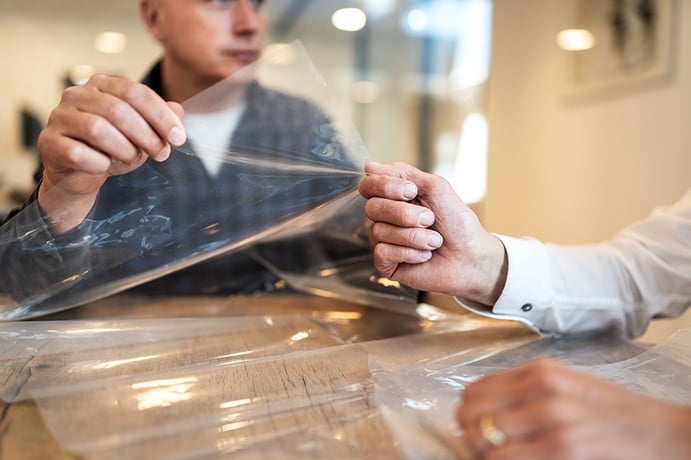All about modified atmosphere packaging
Masterpack is the leading expert in innovative packaging solutions. With our unique and fully integrated solution to create Modified- or Controlled Atmosphere in FIBCs, we provide increased protection and extended shelf life of your products, decreasing waste and loss of product and improving the quality of your products. Learn more about Masterpack and our solutions here, or get in touch for more information.
1. understanding Modified atmosphere
Masterpack Group stands at the forefront of innovative packaging solutions, specializing in Modified Atmosphere Packaging (MAP) and Controlled Atmosphere in FIBCs (Flexible Intermediate Bulk Containers).
Our tailored, fully integrated solutions provide enhanced protection, significantly extend the shelf life of your products, mitigate waste and product loss, and ultimately boost the quality of your offerings.
What is modified atmosphere?
Modified Atmosphere Packaging works by altering the gas composition in product packaging. For example, increasing the proportion of carbon dioxide can slow down bacterial growth, and reducing oxygen levels can slow both microbial growth and oxidative reactions that lead to rancidity or discoloration. The specific gas mixture—commonly a blend of oxygen, carbon dioxide, and nitrogen—is tailored to the product to maximize its freshness and longevity.
Read more: Which gasses are typically used in MAP? (And which aren’t?)
Unlike vacuum packaging, Modified Atmosphere Packaging doesn't necessarily remove all oxygen from the package. Instead, it tailors the oxygen and CO2 levels to optimal values, creating a custom atmosphere that amplifies the shelf life of individual products. The packaging is hermetically sealed to maintain this modified atmosphere.
What are the benefits of Modified Atmosphere?
Modified Atmosphere Packaging (MAP) is a science-based packaging method designed to extend the shelf life and maintain the quality of food products and other products. The science behind it lies in the biology of spoilage organisms and the chemistry of food degradation.
In general, food spoilage is caused by the growth of microorganisms (like bacteria, molds, and yeasts) and the enzymatic reactions within the food. Both of these processes are heavily influenced by the composition of the surrounding atmosphere.
Modified Atmosphere Packaging is a groundbreaking technique that offers substantial advantages extending well beyond supermarket shelves and consumers' kitchens. In an era where food waste is a pressing sustainability issue, Modified Atmosphere Packaging serves as an invaluable tool to combat this global challenge.
The broad benefits of Modified Atmosphere Packaging extend to numerous product types and also contribute significantly to environmental sustainability. Among its key advantages:
- Prolongs product shelf life
- Deters pest invasion
- Prevents microbial growth and oxidation
- Is not harmful to the environment or consumers
- Requires no chemical intervention, making it suitable for organic food
- Enhances product quality
Read more: How FIBCs improve efficiency and productivity

Did you know?
It takes only a hole the size of half the diameter of a human hair to allow oxygen to enter the package. From this, it takes just 70 hours for oxygen levels to rise from 0.1% to 10% - which means a long weekend can have far-reaching consequences.
Read more about how we manage leak prevention here.
2. Mastering the art of modified atmosphere
At Masterpack, innovation is one of our cornerstone values, and we continually strive to refine and develop superior packaging techniques. Here’s how we complete the process for a seamless and sustainable packaging process.
Cleanroom Production technology
This technology optimizes product protection by ensuring our bulk packaging is created in Class 10,000 or 100,000 Cleanrooms, minimizing contamination risks.
A cleanroom is defined in the ISO standard 14644-1 as:
- “A room in which the concentration of airborne particles is controlled, and which is constructed and used in a manner to minimize the introduction, generation, and retention of particles inside the room and in which other relevant parameters, e.g. temperature, humidity, and pressure, are controlled as necessary”
Read more: All About Cleanrooms
Somsix
With SOMSIX, we make the equipment needed for Modified Atmosphere Packaging more accessible by creating a one-stop-shop for all things MAP. This includes state-of-the-art sensors for non-invasive monitoring.
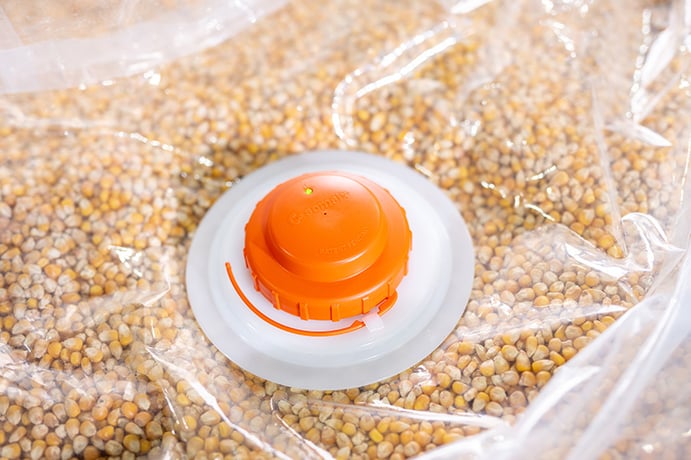
Somsix sensors and non-invasive monitoring
We created patented applied sensors for remote monitoring of oxygen, temperature and humidity. They enable you to have 100% control of your bags, even remotely, helping you to prevent waste and be in charge of your supply chain.
All of our FIBCs are equipped with patented sensor caps that constantly measure and monitor their status. LoRa gateways guarantee safe and accurate data transfer from all bags to your screen.
Research and development
To ensure a seamless implementation of our advanced techniques into your production line, we offer a state-of-the-art R&D center at our headquarters. Here, we work with you to tailor our solutions to your specific needs, without interrupting your existing production processes.
FIBCs made of recycled material
We have developed a new type of FIBC that is made of 30% recycled material, making it one of the most environmentally-friendly options on the market.
The outer bag of the FIBC is partially made from recycled polypropylene (RPP), a thermoplastic polymer that is widely used in many different applications.
Despite being made of recycled material, these bags remain just as strong and safe as the traditional ones. This is a testament to our commitment to producing high-quality products that meet the needs of our customers.
While there is currently no food safety certification for these bags, the market is actively working on obtaining it.
Preventing pest infestation and contamination
Storing food in bulk inevitably presents risks of pest infestation and contamination, both of which can cause significant product loss and potentially harm consumer health. Modified Atmosphere Packaging offers a chemical-free pest control method, eliminating their survival chances by adjusting the atmosphere within the packaging.
Our advanced solutions also tackle other forms of contamination, including physical, chemical, and microbiological hazards.
Leak prevention is a key focus, and we have the expertise to manage this efficiently. For more in-depth insights into how Modified Atmosphere Packaging tackles these issues, check out our whitepaper on pest prevention.
Extending shelf life with modified atmosphere packaging while maintaining quality
Modified Atmosphere Packaging is a game-changer for the food industry, not only protecting products and preventing waste, but also extending shelf life. The technique manages bacteria growth and moisture ingress, ensuring products stay fresh and dry. Furthermore, Modified Atmosphere Packaging does not compromise the flavor, color, or aroma of food products, making it an ideal choice for dried foods, powders, seeds, and more.3. applications of modified atmosphere packaging
Let's talk about where you can really see modified atmosphere packaging (MAP) in action. While you may not always notice it, Modified Atmosphere Packaging is a real game-changer across several industries.modified atmosphere for food
First stop: the food industry. If you've ever opened a bag of fresh salad greens, you've experienced MAP. It's what keeps those leafy greens crisp and fresh even days after you've bought them. Similarly, it extends the shelf life of meats, cheeses, ready-to-eat meals, and even bakery items.
With our FIBC technology, we’re able to extend the benefits of Modified Atmosphere Packaging to products like grains, nuts, dairy, rice, powdered foods and more.
3 powders and their storage challenges: how Modified Atmosphere Packaging helps
modified atmosphere for pharma
The journey doesn't stop there, though. Modified Atmosphere Packaging is also a big player in the pharmaceutical industry, keeping pills and powders in good shape, and safe to use.
Modified Atmosphere is the way to go for the pharmaceutical industry
Modified Atmosphere for argiculture
Finally, in agriculture, Modified Atmosphere Packaging plays a vital role in preserving the freshness and quality of harvested produce during transportation and storage, for instance, in the storing of cannabis.
Big Bag benefits for agricultural products
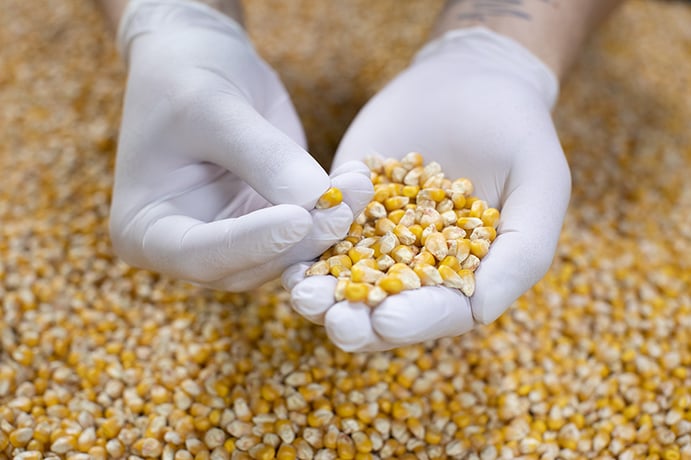
4. understanding the process
Now, let's demystify how the Modified Atmosphere Packaging process actually works. Let's take a closer look at how each step plays a critical role in product preservation and sustainability.
Step 1: preparation
Before we start, every aspect of the product is assessed. From its physical characteristics to its sensitivity to oxygen, humidity, or other atmospheric factors, a complete understanding is crucial for designing the right atmosphere.
Step 2: Sealing
We seal the package to keep the modified atmosphere intact. Special packaging materials are used that have just the right balance of permeability, allowing minimal exchange with outside air while maintaining the desired atmosphere within.
Step 3: Applying a low vacuum
When the back is secure, we create a vacuum in the bag. We can reach significantly low levels of remaining oxygen with our technique and machines. How low we go depends on the product – it can be below 5%, 3% or even below 1%.
Step 4: Gas flushing with CO2, N2 or a mix
Here's where we flush out the regular air within the packaging and introduce a custom-mixed cocktail of gasses. This mixture is typically made up of nitrogen, oxygen, and carbon dioxide, each playing a distinct role in the preservation of the product. By reducing oxygen levels, we can inhibit the growth of bacteria and other spoilage organisms, while carbon dioxide can inhibit mold growth.
Step 5: Inspection and Monitoring - No process is complete without a thorough inspection
Advanced technologies are used to ensure the gas mix is correct and the seal is secure. The quality control checks continue even after packaging, monitoring the product during its shelf-life to ensure optimum preservation.
5. Equipment needed for MAP
What equipment is needed to create a modified atmosphere in FIBCs? Let's delve into the essential machinery required for this process, all provided by Somsix.
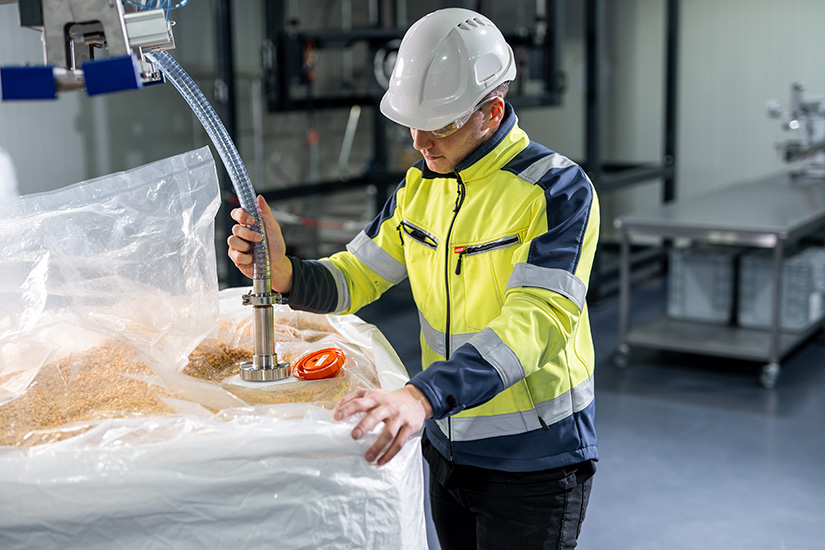
KEy equipment for Modified Atmosphere packaging creation
Initially, the liner spout should be sealed with the Automatic Spout Sealer. Once the spout is set in the seal mouth, the sealing occurs automatically. Crucially, you'll require a Vacuum and Gas Injection Machine, which expels air from the sealed container. Following this, gasses like nitrogen or carbon dioxide can be introduced into the container via an injector system.
Vacuum & Gas injection machine
When compared to competitors' equipment, the Somsix vacuum and gas injection machine excels in efficiency and effectiveness. It can rapidly achieve ultra-low oxygen levels below 1%.
Moreover, the Somsix machine facilitates the creation of a vacuum and the injection of necessary gasses in one cycle, leading to increased productivity and a streamlined process.
Every bag is automatically checked, thanks to an inbuilt leak test at the end of each cycle. This innovative feature can help avoid costly errors due to undetected leaks.
Whether your process requires mobility or a fixed setup, both options are constructed to the highest quality standards.
With a design originating from machines developed for the infant formula and powdered milk industry, our machines adhere to the utmost hygiene standards.
The equipment is user-friendly and secure, designed for accessibility and simplicity. Automated settings further enhance user convenience, allowing anyone to operate the machine under optimal conditions without specialized knowledge.
Automatic spout sealer
This machine seals the spout of a Big Bag, ensuring the FIBC remains securely sealed to maintain the MAP. The sealing process starts automatically once the spout is positioned in the seal mouth.
The Somsix automatic spout sealer represents a significant improvement in an industry where hand-operated sealers are still prevalent. It provides a consistent, high-quality seal with reduced risk of human error.
Integrated heating and cooling systems activate at the push of a button, simplifying the process further.
All-in-one machine: two positions
For those aiming to boost production, our two-position all-in-one machine can significantly streamline the process.
Additional equipment needed
Besides the vacuum chamber, injector system, and sealing system, you might require additional equipment like scales or air compressors tailored to your specific needs.
Gas mixer/generator
Creating a modified atmosphere in FIBCs requires a key tool: a gas mixer or generator. This device is used for blending gasses at particular ratios.
By adjusting the proportion of each gas, it's possible to create an environment that not only safeguards goods but also prolongs their shelf life.
cylinder valves and regulators
These components are vital for controlling the flow rate and pressure of each gas, enabling the desired atmosphere within the container.
For these to function effectively, they must be correctly installed and calibrated per manufacturer instructions.
Installing the somsix equipment
Somsix equipment can be installed and set up by any mechanic. The necessary electrical connections are straightforward.
With our international network of distributors, the majority of machine parts can be sourced locally. Any specialized components are supplied by us in a kit, ensuring uninterrupted operation.
Our machines require minimal maintenance, are built to last, and come with a one-year manufacturer warranty and online support.
Post-Modified Atmosphere Packaging Creation: Monitoring With Smart Sensors
Creating Modified Atmosphere Packaging is just the first step; it also needs to be monitored. Learn more about the tools we offer for this task here or contact us for a demo.
Making the switch to MA — What you need to know
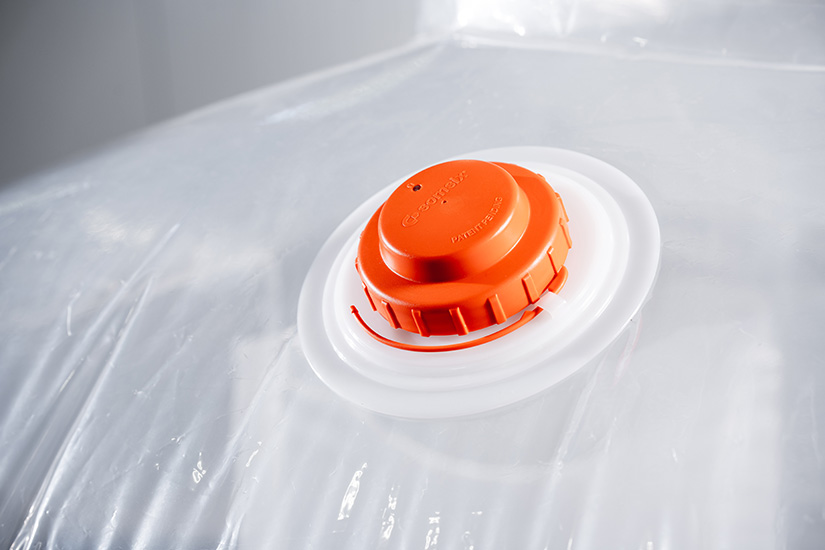
6. Why MAP is key to a sustainable supply chain
Modified Atmosphere Packaging isn’t just a star when it comes to preservation, it's also a champion for sustainability. How so, you ask? Let’s dive in.
Modified Atmosphere Packaging reduces food waste
Modified Atmosphere Packaging significantly extends the shelf life of food products, meaning less spoilage and less waste. When we throw out spoiled food, we're not just wasting the product itself, but all the resources that went into producing it - water, labor, energy, and more. By cutting down on food waste, Modified Atmosphere Packaging also reduces resource waste.
Modified Atmosphere Packaging enables efficient transportation and storage
With the enhanced shelf life, products can be shipped over longer distances without fear of spoilage. This opens up new markets and reduces the pressure to rely on energy-intensive air freight. Additionally, the longer shelf life allows for better inventory management, reducing overstocking and the associated storage and refrigeration costs.
Modified Atmosphere Packaging requires minimal packaging
Modified Atmosphere Packaging doesn’t require the bulky, multi-layered packaging that other preservation methods might need. By minimizing the packaging materials used, Modified Atmosphere Packaging reduces manufacturing and disposal impacts, making it a greener choice.
Modified Atmosphere Packaging equals chemical-free preservation
Traditional preservation methods often use chemical additives to extend shelf life and maintain product quality. These chemicals can be problematic. For starters, some consumers prefer to avoid them, leading to a growing demand for more natural food products.
Additionally, the manufacturing, use, and disposal of these chemicals can create environmental issues. MAP, on the other hand, uses naturally occurring gasses to achieve the same preservation goals. This chemical-free process aligns with the clean label trend and offers a more eco-friendly preservation solution.
Modified Atmosphere Packaging has a reduced environmental impact
By avoiding chemical preservatives, Modified Atmosphere Packaging also sidesteps the environmental harm associated with them. For instance, certain chemicals can contribute to water pollution when products are discarded or when manufacturing waste is improperly managed.
In contrast, the gasses used in Modified Atmosphere Packaging – oxygen, nitrogen, and carbon dioxide – are part of the natural air around us. When a Modified Atmosphere Packaging package is opened, these gasses simply return to the atmosphere without causing harm.
Modified Atmosphere Packaging is energy efficient
The Modified Atmosphere Packaging process is also highly energy-efficient compared to some other preservation techniques. For example, canning or freezing foods requires a significant amount of energy for heating or cooling. With MAP, the energy input is primarily related to the gas flushing and sealing process, which is less energy-intensive.
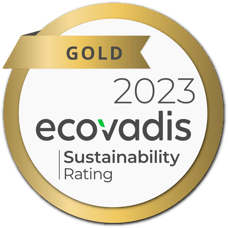
Modified Atmosphere Packaging supports biodiversity
By reducing reliance on chemical preservatives, which are often derived from non-renewable resources like petroleum, Modified Atmosphere Packaging indirectly supports biodiversity.
The extraction and refining of these resources can disrupt habitats and harm wildlife. By choosing MAP, companies can reduce their dependence on these resources and contribute to a more biodiverse planet.
All these factors make Modified Atmosphere Packaging an invaluable tool for a more sustainable supply chain. It isn't just about maintaining product freshness and quality; it's also about doing so in a way that respects and preserves our environment. And that's a mission Masterpack is fully committed to.
Read more about our pledge to sustainability: Sustainability with Masterpack Group
7. regulations and standards in mAP
There are several regulations and standards that govern how Modified Atmosphere Packaging is used.
These rules are here to ensure that Modified Atmosphere Packaging is being used safely and effectively. These standards are set by regulatory bodies like the Food and Drug Administration (FDA) in the US and the European Food Safety Authority (EFSA) in Europe. They outline the safe gas compositions and concentrations that can be used in MAP, as well as packaging material standards.
We're dedicated to providing safe, efficient, and effective packaging solutions. That's why we stay up-to-date with all the latest regulations and work closely with these regulatory bodies to ensure we're not just meeting standards, but exceeding them. We believe in doing right by our customers, our industry, and our planet.
Read more: UN-grade bags: tried and tested for hazardous products
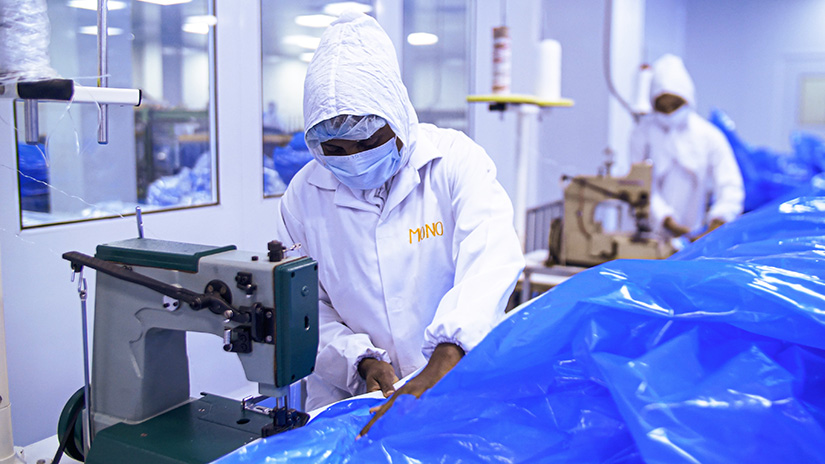
8. the journey of masterpack group
An innovative company that has been around for over a century: Masterpack has been around for longer than you might expect. It was founded in the early twenties of the last century by the de Winter family. It started as Winza Products BV, a packaging company in Enschede, The Netherlands, which traded in jute sacks in the Dutch home market. Over time, the jute has been replaced by synthetic woven materials that were mainly sourced outside of Europe, e.g. in Asia, adapting to changing needs and technologies in the market.
Now, under the fifth generation of the founding family de Winter, the company has not only expanded internationally but has also developed and grown to serve more markets. We have proudly evolved from a good old-fashioned trading company to a leading, innovative, global player in the field of packaging solutions. With a great network of partner suppliers and customers all over the world, Masterpack is part of something big - with all the benefits for its clients.
Why Masterpack?
Choosing Masterpack as your FIBC supplier brings more than just packaging solutions. You gain access to a fully integrated solution for your supply chain, superior product protection, a dedication to environmental sustainability, cleanroom certified production facilities, and a partner experienced in serving clients worldwide. Tell us about your products, and we’ll find a sustainable solution for them.
FAQ
What is Modified Atmosphere Packaging (MAP)?
Modified Atmosphere Packaging is a technique used to extend the shelf life of fresh or minimally processed foods. In this preservation method, the atmosphere inside the packaging is altered, slowing down the natural deterioration process. The combination of gasses in the package (commonly oxygen, carbon dioxide, and nitrogen) is tailored to the specific product to keep it fresh and attractive for as long as possible.
What types of products can benefit from MAP?
A wide range of products can benefit from MAP. These include fresh and processed meats, poultry and fish, fruits and vegetables, bakery products, dairy goods, ready meals, and even some beverages. Besides food, Modified Atmosphere Packaging is also used in the packaging of pharmaceuticals and medical devices, electronic components, and agricultural products to enhance their shelf life and maintain quality.
How does Modified Atmosphere Packaging contribute to sustainability?
Modified Atmosphere Packaging contributes to sustainability in multiple ways. Firstly, by extending the shelf life of products, it reduces food waste, a significant sustainability concern. It also optimizes supply chains, allowing for efficient transportation and storage of goods. Moreover, Modified Atmosphere Packaging avoids the use of chemical preservatives, which reduces environmental harm and aligns with the clean label trend. The process is also energy-efficient compared to some other preservation techniques.
Can Modified Atmosphere Packaging replace other preservation methods?
Modified Atmosphere Packaging is highly effective and can often replace or reduce the need for other preservation methods like chemical additives, freezing, or heat treatment. However, the choice of preservation method depends on the specific product, its intended shelf life, and other factors. In some cases, a combination of methods might be used.
How does Modified Atmosphere Packaging affect the taste of food?
One of the key advantages of Modified Atmosphere Packaging is that it helps maintain the original taste, texture, and appearance of the food product. Because it slows down the natural degradation process without using additives or preservatives, food packaged using Modified Atmosphere Packaging generally tastes as good as fresh, provided it is consumed within the recommended time frame.
How does Modified Atmosphere Packaging extend the shelf life of products?
The process of Modified Atmosphere Packaging (MAP) extends the shelf life of products by slowing down their natural deterioration process. By replacing the air within the packaging with a carefully selected mix of gasses, Modified Atmosphere Packaging can slow bacterial and fungal growth, delay ripening in fruits and vegetables, and prevent color changes or off-odors in meats. Each product requires a unique mix of gasses to achieve the best results. This custom approach to preservation means that food stays fresh and safe for consumption for a longer period of time.
How is Modified Atmosphere Packaging different from vacuum packaging?
Both Modified Atmosphere Packaging and vacuum packaging aim to preserve products and extend their shelf life. However, their methods are different. Vacuum packaging removes all the air from the package before it's sealed, while Modified Atmosphere Packaging replaces the air with a tailored gas mix. The specific gasses used in Modified Atmosphere Packaging can be selected based on the product's needs, while vacuum packaging merely creates an absence of air. Both methods have their benefits and can be more suitable for different types of products. For example, Modified Atmosphere Packaging is often preferred for delicate or moisture-sensitive items, as vacuum packaging can sometimes distort these items or draw out moisture.
How long does Modified Atmosphere Packaging extend a product's shelf life?
The extension of shelf life by Modified Atmosphere Packaging varies greatly depending on the specific product. Some products might only gain a few extra days, while others can have their shelf life extended by weeks or even months. Factors such as the type of product, its initial quality, the gas mix used, and storage conditions all influence the effectiveness of MAP. For more examples, read: the benefits of storing pistachios in bulk under Modified Atmosphere
Does Modified Atmosphere Packaging affect the nutritional value of food?
Modified Atmosphere Packaging is designed to maintain the quality of the food, including its nutritional value. By slowing down the degradation process, it helps to retain the nutrients that are naturally present in the food. However, it's always important to remember that fresh food consumed soon after harvest or production is likely to have the highest nutritional value.
Is Modified Atmosphere Packaging more expensive than traditional packaging methods?
While the initial setup costs for Modified Atmosphere Packaging can be higher due to the need for specialized equipment and gas supplies, the overall cost can be offset by the benefits. These include reduced product loss due to spoilage, extended selling periods for retailers, and the ability to reach distant markets thanks to extended shelf life. The specific cost comparison would depend on the product and specific circumstances.
